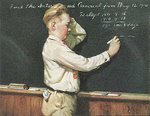 In last year's 109.02 course, the bloggers undertook a covert mission to guest post on a classmate's blog about that particular blog's subject. After everyone read the guest posts and commented on them, the original bloggers wrote follow-ups about the experience of having someone else post on what had been up to that point mainly their text (of course, the inclusion of comments always complicates the ideas of authority and authorship).
In last year's 109.02 course, the bloggers undertook a covert mission to guest post on a classmate's blog about that particular blog's subject. After everyone read the guest posts and commented on them, the original bloggers wrote follow-ups about the experience of having someone else post on what had been up to that point mainly their text (of course, the inclusion of comments always complicates the ideas of authority and authorship).Upon reflection, the "invasion" into their hypertextual space gave the bloggers many things to think about.
- There were discussions of how the guest bloggers opened new avenues for content on the blogs: "What this means to me, to have this post on my blog is that I have a new perspective on how to shape this blog. When I picked this topic, flipping cars for a profit, I thought I had to write only about how I flip cars and what to do right and what to do. From having this post on my blog, I can talk about the cars them self. Not just about my experiences in flipping cars."
- There were realizations that the text can alter the style of the author: "I found in Chase Hardwick’s post the guest writer was more of a joking funny guy compared to Doc Hardwick’s more informal type of posts. He did well by staying with the theme of Doc Hardwick and found a study that showed that in “moderation” (this is a different meaning to everyone) alcohol is beneficial to ones health. But the picture was the main tip off that gave away the fact that it wasn’t Doc speaking in the post."
- And in some cases, the little differences in style stood out to the original authors: i also have noticed a lack of enthusiasm considering a Halo topic is my most favorite topic to write. the writer uses the i have played halo before enthusiasm as opposed to my Halo Geek jargon. Also being that i am a huge Halo fan I would have put a video link from the website G4TV from the episode were they talk about the game Halo Wars. I also noticed that the picture was placed in the middle of the blog and i like to place my pictures in the left hand corner of the post.
*Horrible, horrible pun.















